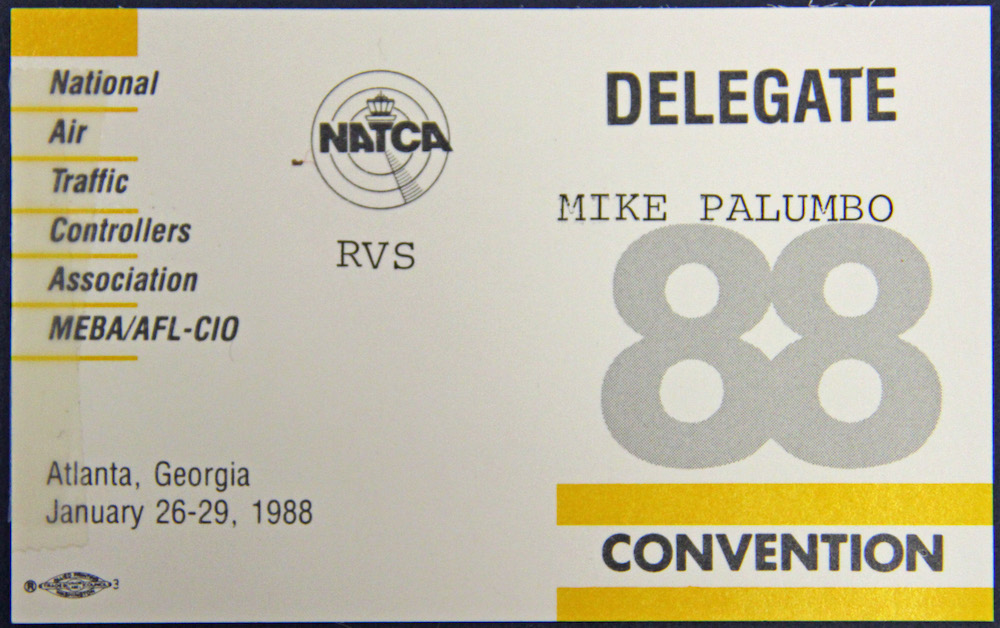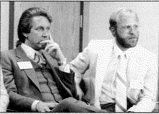
March 3, 2017 // NATCA’s First National Elections
NATCA’s First Elected National Executive Board.
From left to right: Will Faville Jr., Alaskan Region; President Steve Bell; Jim Breen, New England Region; Joseph Bellino, Great Lakes Region; Barry Krasner, Eastern Region; Dan Brandt, Central Region; Executive Vice President Ray Spickler; Lee Riley, Southern Region; Ed Mullin, Southwest Region; and Gary Molen, Northwest Mountain Region. Not pictured is Richard Bamberger, Western Pacific Region.
On January 26, 1988, almost 300 delegates packed the Phoenix Ballroom of the Hyatt Regency Atlanta for NATCA’s second convention. They were seated in nine regional clusters. Their goals included establishing constitution, finance, and safety committees comprising one member from each region; defining an “active” member as a controller who had been certified in the preceding two years or a developmental in a training program; and limiting the right to vote or hold office to “active” members.
The concern over the definition of an active member was rooted in the belief many delegates held that NATCA would have more credibility if its members ran their union. They had concerns over the possibility of John Thornton assuming leadership and intrinsically tying them to the fate of PATCO.
“We want an organization of, by, and for air traffic controllers,” Western Pacific Regional Rep Karl Grundmann told the convention body in support of seeking an alternative option for president.
Controllers who supported Grundmann felt strongly about completely disassociating from PATCO. They feared that NATCA could become another radical organization and opposed Thornton running their new union.
 |
| Retired member Mike Palumbo’s 1988 Convention delegate badge. Palumbo is the the only NATCA member to have attended every NATCA Convention. |
“John’s loyalty and his contribution to NATCA were unparalleled,” said Steve Bell, who was the Eastern Regional Rep at the time. “But there was no way — no way we could campaign to build a union by electing a PATCO guy as the new president.”
New York TRACON FacRep Barry Krasner introduced two constitutional amendments as a result. One resolution defined an active member as a certified controller or a developmental in a training program. The other limited the right to vote or hold office to active members. The measures passed and, as a result, Thornton could no longer seek the NATCA presidency.
Despite this, delegates felt strongly that Thornton was deserving of recognition and they voted to bestow him with the Union’s first honorary lifetime membership in appreciation of his contributions. Thornton went on to become NATCA’s Senior Director of Legislative Affairs and, in 1989, director of the new Political Action Committee.
With Thornton out of the race, this opened the door for an exciting first national election. Heavy lobbying ensued in the hotel’s bars and regional “war rooms,” which were making their first appearance at a NATCA function. The upcoming national election was the topic of choice, as nominations would open the week after the Atlanta convention ended. Voting would take place in the spring and the results would be tallied in July.
Bell was a natural choice for president to some of the membership. He was a gifted speaker and had a strong support base in the Eastern Region where he was a controller at New York TRACON. Grundmann hailed from Los Angeles TRACON and was also a well-respected potential candidate within NATCA. He had his eyes set on the position of executive vice president. Prior to NATCA’s certification, the duo had become friends. Their close working relationship tied them together in the membership’s eyes as a ticket, though the two never formally acknowledged each other as running mates.
 |
| Grundmann (left) and Bell. |
Chicago Center controller Fred Gilbert and Kansas City Center controller Ray Spickler ran together in opposition, hoping their strong Midwestern support would appeal to enough members as a more balanced ticket. Gilbert aspired to the presidency and Spickler to Executive Vice President. At the Atlanta Convention, Spickler gave a stirring speech opposing proposed weighted voting on the National Executive Board (the measure did not pass). It caught the ears of many of the delegates, including Gilbert, and a week later they agreed to form a ticket.
With the unofficial tickets set, the race was on. Gilbert’s link to PATCO proved to be a challenge for the candidate. Additionally, Spickler chose third-class postage to save money, and campaign literature did not arrive in time for voting. When the results were announced on July 18, 1988, Bell outperformed Gilbert by nearly two to one out of more than 3,200 votes cast. Spickler was also behind by about 200 votes, but because neither he nor Grundmann won the majority due to two other candidates who had been in the race, it became a runoff election.
 |
 |
| Gilbert (top) and Spickler (bottom). |
Spickler campaigned hard while Grundmann suffered an untimely bicycle accident that knocked out all of his teeth. A Grundmann campaign worker derailed his campaign further by sending out a letter claiming that Spickler endorsed Grundmann for the position of executive vice president. Spickler battled the claims and ended up winning the runoff with 63 percent of the vote.
As the dust settled, Steve Bell assumed his role as the first elected NATCA president and Ray Spickler the first executive vice president. At the regional level, several interim regional representatives retained their seats, but the 1988 election brought five new faces, forming the first elected National Executive Board.
Bell and Spickler were now working alongside nine regional representatives: Will Faville Jr., Alaskan Region; Dan Brandt, Central Region; Barry Krasner, Eastern Region; Joseph Bellino, Great Lakes Region; Gary Molen, Northwest Mountain Region; Jim Breen, New England Region; Lee Riley, Southern Region; Ed Mullin, Southwest Region; and Richard Bamberger, Western Pacific Region.
The entire board met for the first time after the election on September 12, 1988 on the eighth floor of MEBA headquarters in Washington, D.C. Later that month, they would present the union’s first contract proposal to the FAA.

